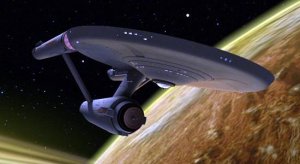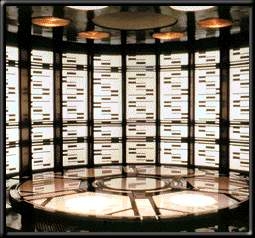Background and contents
The ST:TNG TM is written from the perspective of the 24th century, where TNG is set; it also contains a wealth of behind-the-scenes trivia distinguishable from the technical content. The work is considered by Paramount to be canon in many respects, although some elements first published in the manual have not yet made it onto screen. The book itself claims that elements of it may be false or misleading in order to mislead "threat" forces.
Some ideas developed for the technical manual, or its predecessor, the internal Writers Technical Manual, were later incorporated into the storylines of the TV series and movies. Most notably, a concept drawing from the manual describing an emergency landing of the saucer section was seen by TNG writers Ronald D. Moore, Jeri Taylor, and Brannon Braga who wanted to use a saucer crash as a sixth-season cliffhanger episode for the TV series. This idea was shelved due to budget limitations and resistance from producer Michael Piller. However, Moore and Braga later included the scenario in Star Trek Generations . Also first seen in the technical manual were the Nova-class starship and the USS Galaxy.
The book contains explanations of Warp drive (including a chart showing warp factor against speed, and an explanation that non-fractional warp factors are more efficient than fractional ones), the transporter (which is said to transport matter from place to place keeping it in the form of a "matter stream", and works using analog technology to defeat pattern storage requirements), the replicator (which is said to work on the basis of the transporter, but with a less precise digital resolution), holodecks, phasers and photon torpedoes, impulse drive, the warp core (including a chemical formula for dilithium), subspace radio, saucer separation and landing, the computer, and the various auxiliary craft of the Enterprise. It also contains a section regarding the history of the development of the Galaxy-class ships.

Star Trek: The Next Generation (TNG) is an American science fiction television series created by Gene Roddenberry. It originally aired from September 28, 1987, to May 23, 1994, in syndication, spanning 178 episodes over seven seasons. The third series in the Star Trek franchise, it is the second sequel to Star Trek: The Original Series. Set in the 24th century, when Earth is part of the United Federation of Planets, it follows the adventures of a Starfleet starship, the USS Enterprise (NCC-1701-D), in its exploration of the Milky Way galaxy.

Enterprise or USS Enterprise is the name of several fictional spacecraft, some of which are the main craft and setting for various television series and films in the Star Trek science fiction franchise. The most notable were Captain James T. Kirk's USS Enterprise (NCC-1701) from the original 1960s television series, and Captain Jean-Luc Picard's USS Enterprise (NCC-1701-D) from Star Trek: The Next Generation.
In the Star Trek fictional universe, shields refer to a 23rd and 24th century technology that provides starships, space stations, and entire planets with limited protection against damage. They are sometimes referred to as deflectors, deflector shields, and screens.

A transporter is a fictional teleportation machine used in the Star Trek science fiction franchise. Transporters convert a person or object into an energy pattern, then "beam" it to a target location, where it is reconverted into matter ("rematerialization").
A warp drive is a fictional superluminal spacecraft propulsion system in many science fiction works, most notably Star Trek, and a subject of ongoing physics research. A spacecraft equipped with a warp drive may travel at speeds greater than that of light by many orders of magnitude. In contrast to some other fictitious faster-than-light technologies such as a jump drive, the warp drive does not permit instantaneous travel and transfers between two points, but rather involves a measurable passage of time which is pertinent to the concept. In contrast to hyperspace, spacecraft at warp velocity would continue to interact with objects in "normal space". The general concept of "warp drive" was introduced by John W. Campbell in his 1957 novel Islands of Space.

USS Voyager(NCC-74656) is the fictional Intrepid-class starship which is the primary setting of the science fiction television series Star Trek: Voyager. It is commanded by Captain Kathryn Janeway. Voyager was designed by Star Trek: Voyager production designer Richard D. James and illustrator Rick Sternbach. Most of the ship's on-screen appearances are computer-generated imagery (CGI), although models were also sometimes used. The ship's motto, as engraved on its dedication plaque, is a quote from the poem "Locksley Hall" by Alfred, Lord Tennyson: "For I dipt in to the future, far as human eye could see; Saw the vision of the world, and all the wonder that would be."

USS Enterprise (NCC-1701-D), or Enterprise-D, is a starship in the Star Trek media franchise. Under the command of Captain Jean-Luc Picard, it is the main setting of Star Trek: The Next Generation (1987–1994) and the film Star Trek Generations (1994). It has also been depicted in various spinoffs, films, books, and licensed products.
This article discusses the fictional timeline of the Star Trek franchise. The franchise is primarily set in the future, ranging from the mid-22nd century to the late 32nd century. However the franchise has also outlined a fictional future history of Earth prior to this, and, primarily through time travel plots, explored both past and further-future settings.

Enterprise is a fictional spaceship that appears in the American science fiction television series Star Trek: Enterprise. It had the in-universe registration of NX-01 and appeared earlier in the franchise timeline than any other Starfleet ship named Enterprise.
The Star Trek franchise has produced a large number of novels, comic books, video games, and other materials, which are generally considered non-canon.

Michael Okuda is an American graphic designer best known for his work on Star Trek.
Richard Michael Sternbach is an illustrator who is best known for his space illustrations and his work on the Star Trek television series.

Star Trek: The Role Playing Game is a role-playing game set in the fictional Star Trek universe published and edited by FASA Corporation from 1982 to 1989.
"Booby Trap" is the sixth episode of the third season of the American science fiction television series Star Trek: The Next Generation, the 54th episode overall, first broadcast on October 30, 1989.
"A Matter of Perspective" is the 14th episode of the third season of the American syndicated science fiction television series Star Trek: The Next Generation (TNG), and the 62nd episode of the series overall. It was inspired by Akira Kurosawa's 1950 film Rashomon. The 45-minute episode was broadcast on February 12, 1990 on television. It was written by Ed Zuckerman.
"Galaxy's Child " is the 90th episode of the American science fiction television series Star Trek: The Next Generation, the 16th episode of the fourth season. It was originally released on March 11, 1991, in broadcast syndication.

The Star Trek franchise features many spacecraft. Various space vessels make up the primary settings of the Star Trek television series, films, and expanded universe; others help advance the franchise's stories. Throughout the franchise's production, spacecraft have been depicted by numerous physical and computer-generated models. Producers worked to balance often tight budgets with the need to depict convincing, futuristic vessels.
The following outline is provided as an overview of and topical guide to Star Trek:

Star Trek Maps is a reference work demonstrating the stellar cartography and navigation system featured on the Star Trek television series, written from an in-universe perspective. It was published by Bantam Books in August 1980, and licensed by Paramount Pictures.










